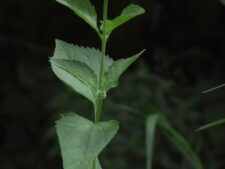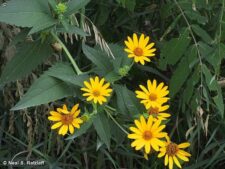
FALSE SUNFLOWER
Heliopsis helianthoides
SUNFLOWER FAMILY (Asteraceae)
 Identification
Identification
- Flowering period - July, August, September, occasionally October
- Common in prairies at NW
- Erect flowers with convex, yellow central disk
- Stalked, opposite leaves
- See comments for comparison with other 'sunflowers'
This native, erect perennial grows 3-5 feet tall. The opposite, short-stalked, coarsely toothed, triangle-shaped leaves are 2-6 inches long (B,C). The erect 2-3 inch wide flower heads are on stout stalks arising from the stem or junction of the leaf and stem. They have 10-16 yellow to orange-yellow petal-like ray florets (C) and a raised, rounded center composed of many small, yellow, 5-lobed disk florets (A). The central disk becomes darker and more convex as the disk florets mature. Ray florets often persist well after the fruits have formed.
Grows in the tall grass prairie, both upland and lowland, and along woodland edges, flowering from July through October. It is common in many of the restored prairies at Neale Woods.
The convex, round disk and stalked, opposite leaves separate false sunflower from the true sunflowers (“flatheads”) of the genus Helianthus. Flower heads also are erect while most of our true sunflowers nod. Composite yellow flowers in the genus Rudbeckia (“coneheads”) also have raised central disks, but they are more cone-shaped.
False Sunflower (Heliopsis helianthoides), is not classified as a true sunflower because both the ray and disk florets are fertile and capable of producing seeds. In our more common and familiar true sunflowers (Helianthus species) the showy ray florets are sterile and only the disk florets produce seed.
Ox-eye in various iterations is included in several alternate common names, likely prompted by the resemblance of its convex central disk to a large eye.
The content of NatureSearch is provided by dedicated volunteer Naturalists of Fontenelle Forest who strive to provide the most accurate information available. Contributors of the images retain their copyrights. The point of contact for this page is: Neal Ratzlaff.


